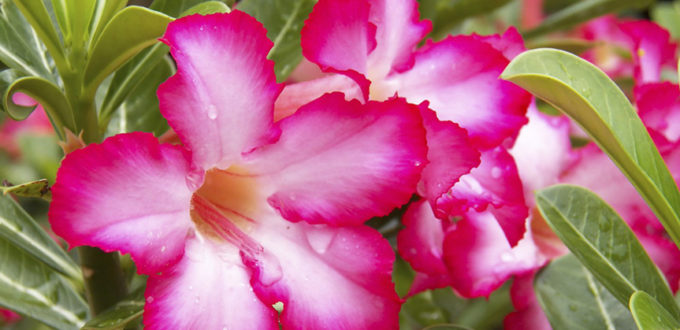Common Name: Desert Rose, Sabi Star, Mock Azalea, Impala Lily
Scientific Name: Adenium obesum
Type of Plant: Perennial
Description: The desert rose is a slow-growing plant, only growing about 12 inches per year. It is often used as a bonsai plant thanks to its thick succulent trunk, thin and delicate leaves, and luscious, deep pink trumpeting flowers. It is native to Africa, the Middle East, and Madagascar. The plant typically blooms during the summer months, erupting with vibrant pink, rose, or red flowers and bright green leaves. When it goes dormant for the winter season, it drops its flowers and foliage.
Mature Size: 3-9′ tall x 3-5′ wide
Blooms: White, Red, or Rose; Bloom time Summer
Fruit: no
Climate Requirements: It’s best planted in the spring, and it will die if exposed to frost and freezing temperatures. The desert rose plant thrives in a full sun environment, so select a spot in your garden that is not shaded by taller plants but has some protection from high-noon sun, which can scorch the plant’s leaves.
Care Requirements: Tending to a desert rose plant is simple, but it does take some finesse. Similar to other succulent plants, it needs careful water management and lots of sunlight. For an added dose of nutrients (and potentially more flowers), you can feed your desert rose with liquid fertilizer (diluted by half) once a month during its active growth period. Do not fertilize the plant during its dormant period.
Before pruning, use rubbing alcohol or a bleach solution to sterilize your pruning tools; re-sterilize as you move from one plant to the next. Remove cold-damaged growth as soon as new growth emerges. Trim long, lanky stems to balance the stem growth symmetrically. Remove branches that rub or cross other branches, cutting just above a leaf node or where the stem joins with another stem.
Spacing: Space plants 24-36″ apart
Water Needs: The desert rose plant has varying water requirements depending on the time of year and temperature. During its growing season (late spring and summer), keep its soil moist but never saturated. Check on the soil periodically and allow it to dry out completely before watering. In the fall and winter months (when the plant typically goes dormant in the wild); drastically reduce moisture, watering only minimally once a month or so. If you’re curious if your plant is receiving enough water during its growing season, you can look at its trunk for the answer. A swollen, thick trunk (in proportion to the size of your plant) is a great indication that your plant is well-hydrated.
Maintenance: Low
Special Uses/Attributes: A member of the dogbane family, the sap of the desert rose plant is toxic to people and pets.
Florida Native: No

